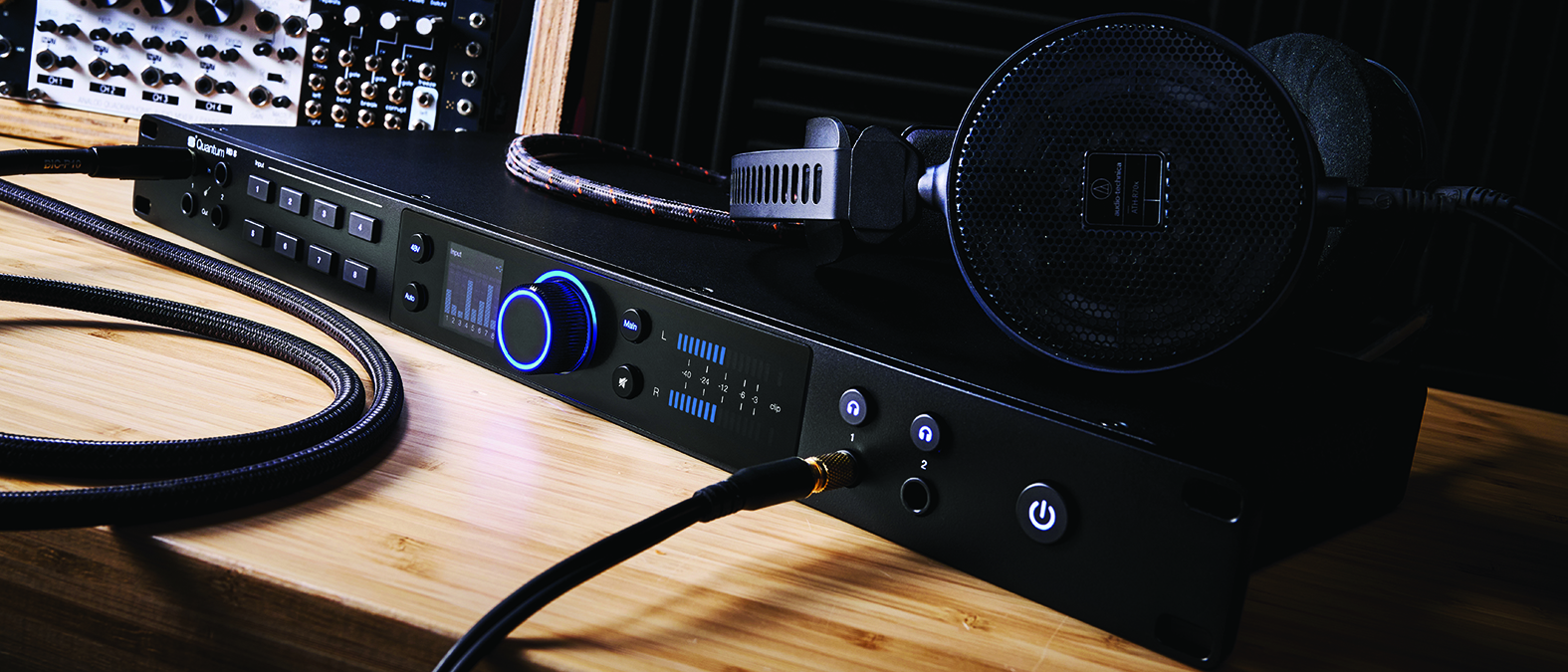MusicRadar Verdict
A solid upgrade from PreSonus that couples audio fidelity and stylish visuals with ease of use and good software.
Pros
- +
Low noise, high gain mic preamps
- +
Useful, hassle-free auto-gain feature
- +
Good connectivity including instrument re-amp and MIDI I/O
- +
Universal Control support software with mobile app WiFi control.
- +
Impressive Studio One software bundle.
Cons
- -
No front-mounted microphone input
MusicRadar's got your back
PreSonus Quantum HD 8: What is it?
Presonus’ latest updated Quantum series offers both rackmount (Quantum HD) and desktop (Quantum ES) designs to meet a broad range of users. On the bench, we have the top-of-the-range Quantum HD 8.
Conceptually, the Quantum HD 8 is not unlike the original Quantum interface, and you get soft knob control of the inputs, outputs and headphone levels, with switchable input and output metering.
In terms of physical layout, all eight mic inputs are on the back, so sadly there’s no front-mounted mic input. That said, inputs 1 & 2 also double as instrument inputs and these do have front panel jacks.

For outputs there are 10 rear-mounted TRS jacks and a pair of front-mounted headphone outputs. Below the instrument inputs you also get a pair of re-amp outputs. These are available as specific outputs in your DAW, and provide the correct impedance output for plugging directly into a guitar amp or pedal, so you can re-amp your DI recording. This is a great idea and worked really well in practice.
Interfacing is via USB-C, and the new Quantum devices support Windows, Mac OS X, Android, ChromeOS and Apple iOS/iPad OS. PreSonus’ USB drivers deliver very impressive round trip latency, and in Logic Pro we got a round-trip latency of 4.1ms with buffer size 32 at sample rate 44.1kHz.

PreSonus Quantum HD 8: Performance and verdict
The Quantum HD 8 features PreSonus’ new MAX-HD digitally controlled analogue mic preamps, which offer a whopping 75dB of gain and include auto gain. We found these to be very quiet at high gain settings, although as is often the case with digital control, there is slight stepping noise when changing gain. Using the HD 8 from the front panel provides easy access to key features, including auto gain and 48V phantom, while further features such as -20dB input pad and low-cut filter are accessed via the main knob and screen.
PreSonus’ Universal Control software replicates all of these options and adds management of minimal latency cue mixes. Settings can be saved as recallable Scenes. Further options include alternate speaker switching, output mono/stereo, and the main encoder output behaviour. This can be set to control multiple outputs, ideal for a multi-channel speaker system. Universal Control has one further trick up its sleeve as the portable device app allows remote control of the Universal Control desktop app.
Want all the hottest music and gear news, reviews, deals, features and more, direct to your inbox? Sign up here.
Rounding off the package, Quantum HD 8 comes with a 12-month subscription to PreSonus’ Studio One+ service. This includes loads of exclusive content, add-ons and tools such as creator presets, Notion notation software and expert livestreams. You will also get the benefit of a perpetual licence for Studio One Professional (normally $400), which includes an impressive selection of core plugins, instruments and content.
All told, Quantum HD 8 is a well designed and well spec’ed unit that builds considerably on the previous top-end Quantums.
MusicRadar verdict: A solid upgrade from PreSonus that couples audio fidelity and stylish visuals with ease of use and good software.
PreSonus Quantum HD 8: Hands-on demos
PreSonus Audio Electronics
Bolo Da Producer
Riffs, Beards & Gear
Marcus Huyskens Music
PreSonus Quantum HD 8: Specifications
- KEY FEATURES: i/0: Analogue: 8 mic/line inputs, 10 line outs, 2 re-amp outs, 2 headphone outs, Digital: ADAT 16 I/O at 44.1/48kHz, 8 I/O at 88.2/96kHz, S/PDIF 2 I/O Mic/Instrument Gain: 75dB Line Gain: +/-10dB Mic Input Dynamic Range: 116dB (A-Weighted, minimum gain).
- CONTACT: PreSonus
Jon is a London based platinum award winning mixer, producer, composer and club remixer with a diverse CV that spans dance, pop, rock and music for media. He’s also a long term contributor to MusicRadar's music technology tutorials and reviews. Whether working alone or collaborating he usually handles final mixdowns, so you’ll also find MusicRadar peppered with his handy mixing tips.





